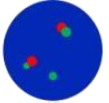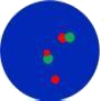Product Cat. No.: GBS-179-2
For Research Use Only.
EVI gene break apart probe reagent
10 Tests/box
The kit is available in two pre-packages, Pre-Package 1 uses Orange and Green fluorescein to label the EVI1 probe, Pre-Package 2 uses Orange, Green and Aqua fluorescein to label the EVI1 probe, which can be conjugated to the target detection site by fluorescence in situ hybridization.The EVI1 probes are labeled with Orange (Green) and Cyan (Aqua) fluorescein.
The kit consists of EVI1 dual color probe or EVI1 tri color probe as shown in Table 1.
| Cat# | Component name | Specifications | Quantity | Main components |
|---|---|---|---|---|
| GBS-179-1 | EVI1 dual color probe | 100μL/Tube | 1 | EVI1 Orange probe ; EVI1 Green probe |
| GBS-179-2 | EVI1 tri color probe | 100μL/Tube | 1 | EVI1 Orange probe ; EVI1 Green probe ; EVI1aqua probe |


Keep sealed away from light at -20°C±5°C. The product is valid for 12 months. Avoid unnecessary repeated freezing and thawing that should not exceed 10 times. After opening, within 24 hours for short-term preservation, keep sealed at 2-8°C in dark. For long-term preservation after opening, keep the lid sealed at -20°C±5°C away from light. The kit is transported below 0°C.
Fluorescence microscopy imaging systems, including fluorescence microscopy and filter sets suitable for DAPI (367/452), Green (495/517), Aqua (423/480) and Orange (547/565).
The following reagents are required for the experiment but not provided in this kit

Negative:2 fusion

Positive : 1 orange 1 green 1 fusion

Positive : 2 fusion 1 green (suggests that the EVI1 breakpoint is located in the green labeled region)

Positive : 2 fusion 1 orange (suggeststhat the EVI1 breakpoint is located in the orange labeled region)

Negative:2 orange-green-aqua fusion

Positive: 1 aqua; 1 orange-green fusion; 1 orange-green-aqua fusion

Positive : 1 green; 1 orange-aqua fusion; 1 orange-green-aqua fusion (suggests possible EVI1 translocation)

Positive : 1 orange-aqua fusion; 1 orange-green; 1 orange-green-aqua fusion
1.The results of this kit will be affected by various factors of the sample itself, but also limited by hybridization temperature and time,operating environment and the limitations of current molecular biology technology, which may lead to wrong results.
2.Users must understand the potential errors and accuracy limitations that may exist in the detection process.
3.All chemicals are potentially dangerous. Avoid direct contact. Used kits are clinical waste and should be properly disposed off.
